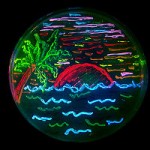Fluorescent Controversy
 After conducting a bacterial transformation lab with my students, where we genetically engineer the bacteria to make a jellyfish protein that fluoresces, we always jump into the discussion of why this technique is important. I always try to get the students to think of ways that this could benefit them.
After conducting a bacterial transformation lab with my students, where we genetically engineer the bacteria to make a jellyfish protein that fluoresces, we always jump into the discussion of why this technique is important. I always try to get the students to think of ways that this could benefit them.
Among other uses, we finally get to the idea that these bacterial cells can be used as factories to make any protein you want, even human proteins. It all depends on what recipe, or gene, you give them. If you give them the recipe to make human insulin, they will. And then this insulin can be used to treat diabetes.
They can see the benefits when discussing bacteria, but once I show them a picture of a multicellular organism that has been engineered with this protein, such as a pig or monkey, the debate begins to heat up. That while the protein is harmless to the organism, they don’t feel it is necessary to make pigs glow. While this may be true, many researchers would beg to differ.
Researchers use this protein in many studies that were once invisible. If they are studying the production of a protein, maybe when the protein gets produced during development, or in what type of cell it gets made, they can visualize this process with the help of the green fluorescent protein. This will hopefully give insight to many disorders that result from the faulty production of a protein. We need to see how and when the process works normally to gain more information about when it does not work. Then we can hopefully use this information to fix it.
Many debates arise during discussions involving genetic research because of the potential benefits that could arise from the study, while disturbing a few people or groups along the way. These are good discussions to have with students though, as they may be faced with decisions in the future about potential career choices or matters that will affect them on a more personal level.
| Print article | This entry was posted by Jennifer Galasso on August 13, 2010 at 8:43 am, and is filed under DNA Interactive. Follow any responses to this post through RSS 2.0. You can skip to the end and leave a response. Pinging is currently not allowed. |


